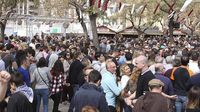Castellón's Magdalena Festivities in 2025 have significantly boosted hotel occupancy rates, achieving an impressive average of 75% across the province. This figure reflects the vibrant atmosphere during the festivities, particularly notable during the first weekend from March 21 to March 23, when occupancy soared to 78.2%. The following weekend, from March 28 to March 30, saw an even higher occupancy rate of 89.2%, according to data released by the Hosbec tourism business association.
These results come amid a broader positive trend in hotel occupancy for Castellón throughout March 2025, which recorded a rate of 70.1%, a slight increase from the 69.5% occupancy seen in March 2024. The second half of March specifically showed a hotel occupancy rate of 67.3%, which is marginally above the 66.7% recorded during the same period last year.
National tourism continues to be the driving force behind Castellón's demand, comprising 84.6% of arrivals in the second half of March 2025, up from 82.2% in 2024. Meanwhile, the presence of international tourists remains moderate, with France leading as the primary source of foreign visitors at 5.2%, followed by China at 1.4% and Germany at 1.3%.
Looking ahead, Hosbec forecasts a hotel occupancy rate of 65.5% for the second half of April 2025, which is expected to surpass last year's figure of 60.1%. This anticipated growth is attributed to a steady influx of both national and international visitors during the upcoming Semana Santa, or Holy Week.
In addition to Castellón, nearby Benidorm has also reported a positive trend in hotel occupancy. In March 2025, Benidorm achieved a rate of 77.8%, compared to 75.7% in March 2024. The second half of March recorded an occupancy of 78.5%, exceeding the previous year's rate of 74.3% by four percentage points. The British market has notably reinforced its position as the leading source of tourists, contributing 47.3% of arrivals in the second half of March, a significant rise from 38% in 2024.
This increase in British tourists is partially attributed to the celebration of St. Patrick's Day, a popular holiday among UK visitors. In contrast, domestic tourism in Benidorm saw a decline, dropping from 49.2% to 35.6% of total visitors.
Four-star hotels in Benidorm performed particularly well, achieving an occupancy of 78.5% in the second half of March, compared to 71.9% in the same period last year. The overall forecast for the second half of April 2025 in Benidorm stands at 75.7%, which is an improvement over the 71.5% recorded in 2024. Hosbec anticipates that the upcoming Semana Santa will further enhance tourist arrivals, solidifying Benidorm's appeal as a tourist destination.
Meanwhile, the Costa Blanca region maintained stable hotel occupancy throughout March 2025, with a rate of 76.3%, slightly down from 77.4% in the same month of 2024. In the second half of March, occupancy was recorded at 76.5%, a minor decrease from 77.3% during the previous year. Despite this slight dip, the region remains a key player in the vacation tourism sector, thanks to its favorable climate and diverse services.
Interestingly, the profile of visitors to the Costa Blanca has shifted, with a notable increase in international tourists. British and Belgian visitors accounted for 14% and 8% of travelers, respectively, during the second half of March 2025. This marks a significant change from the same period in 2024 when domestic tourism was more pronounced, comprising 54.1% of visitors.
Hotels in the Alicante Sur area have also reported outstanding performance, closing March 2025 with an impressive occupancy rate of 82.1%, significantly higher than the 76.8% achieved in 2024. In the second half of March, Alicante Sur reached an occupancy rate of 80.5%, compared to 76.5% in the previous year. National tourists continued to dominate this market, making up 68.3% of reservations during the last fortnight.
As for the province of Valencia, it experienced a decline in hotel occupancy during March 2025, registering a rate of 72%, down from 80.6% in March 2024. The second half of the month saw an occupancy of 71.9%, which is lower than the 80% recorded in the same period last year. However, the city of Valencia outperformed the provincial average, achieving an overall occupancy of 74.7% for March 2025.
During the second half of March, the city reached an occupancy rate of 75.6%. The national market remains the primary source of visitors to the province, with 49.6% of tourists in the second half of March 2025. However, the city of Valencia attracted a slightly lower percentage of domestic tourists at 34.7%, indicating a growing appeal for international visitors during this period.
Among the international markets, the United States (10%), the United Kingdom (8.2%), and Germany (7.2%) were the leading sources of foreign tourists in Valencia. Hosbec has noted a significant increase in American visitors during this time.
Looking forward, the forecast for hotel occupancy in Valencia for the second half of April 2025 is 62.7% for the province and 71.1% for the city, reflecting a decrease compared to the previous year. Nonetheless, the upcoming Semana Santa festivities are expected to boost occupancy levels, particularly in the capital, where a more dynamic demand is anticipated.
Despite the positive outlook, both the province and the city of Valencia are still grappling with lingering uncertainties related to the impact of recent weather events, which have affected perceptions among potential tourists outside of Spain. This uncertainty continues to pose challenges for the region's tourism sector.





